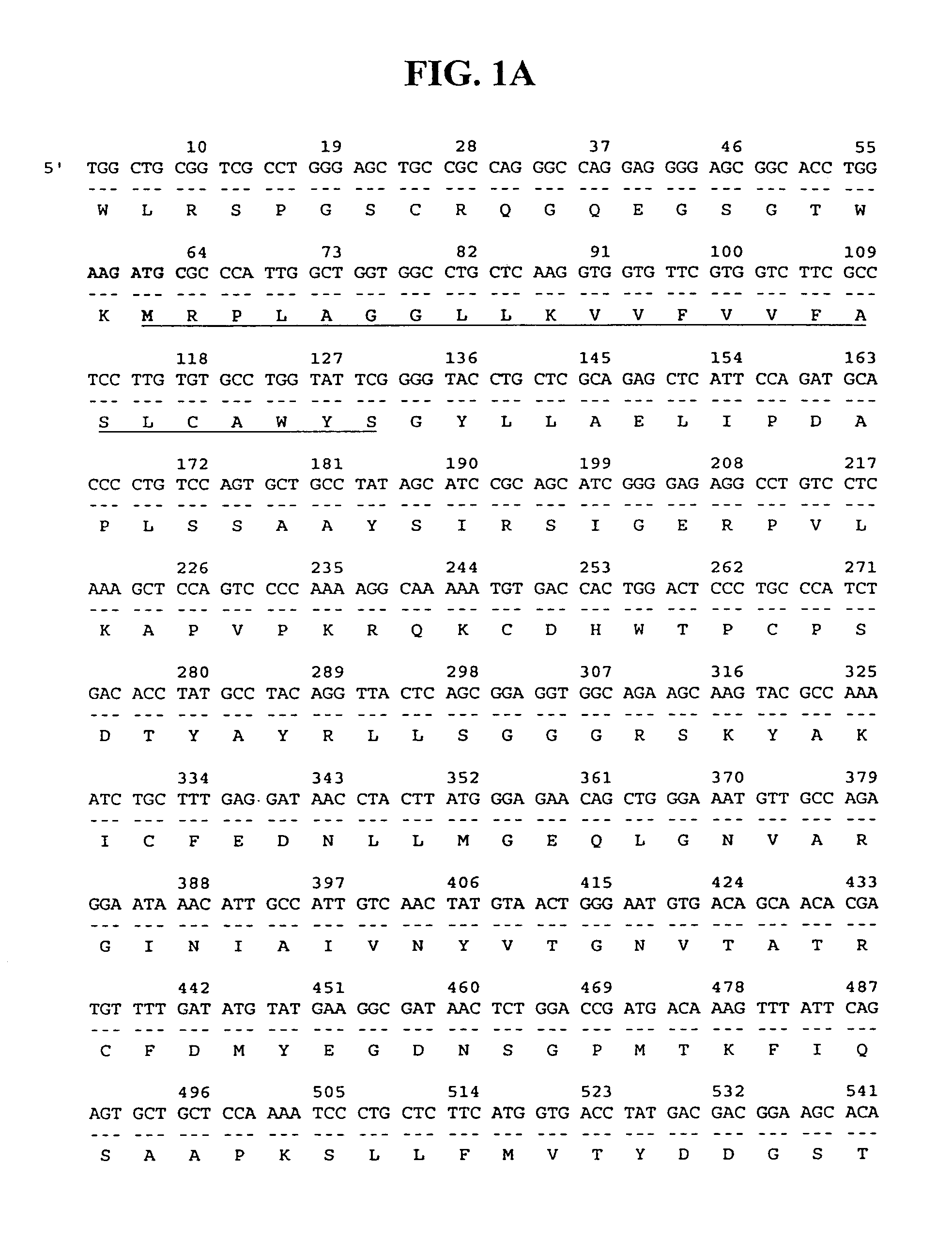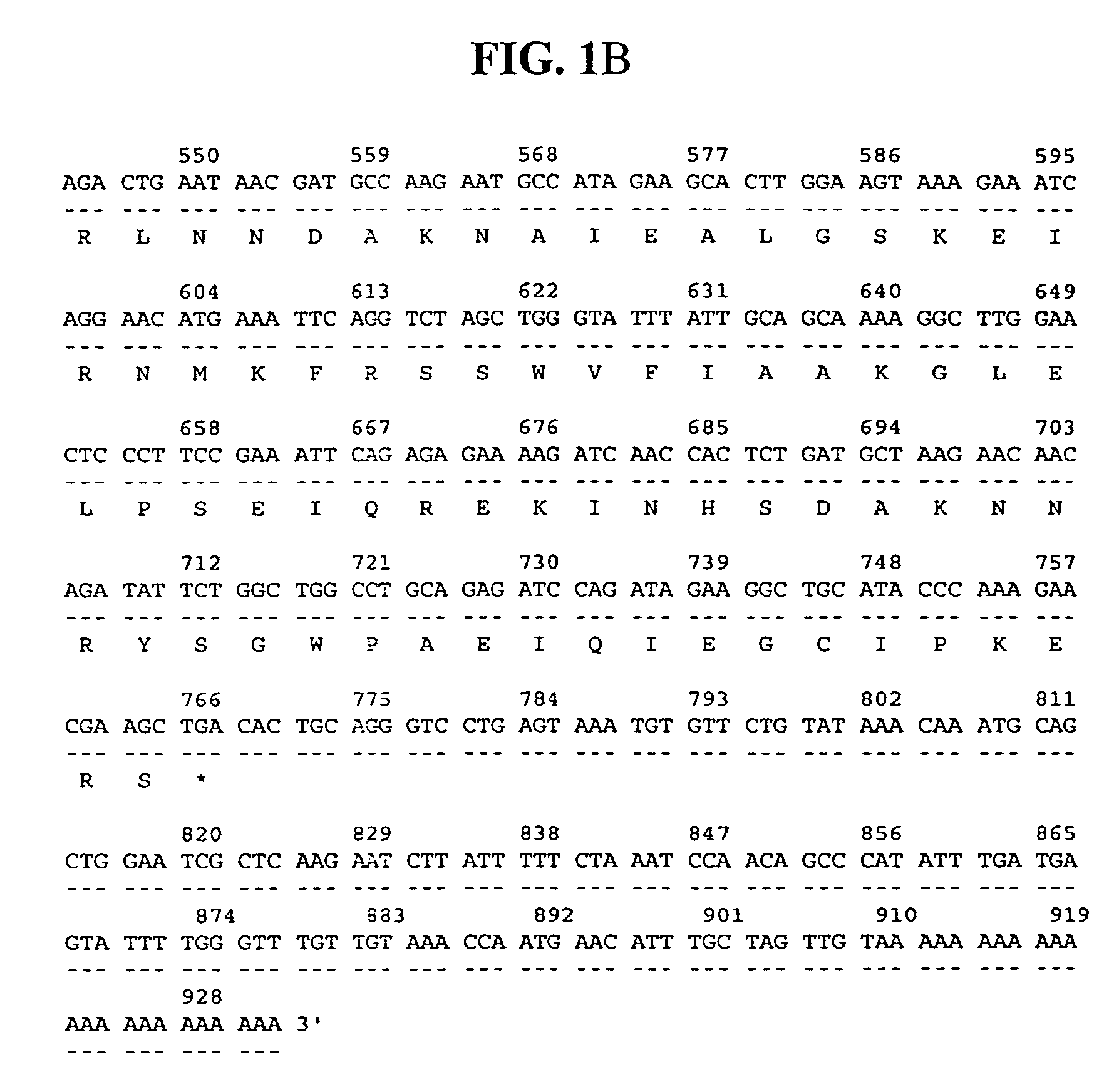36P6D5: secreted tumor antigen
a tumor antigen and secreted technology, applied in the field of 36p6d5, can solve the problems of ineffective and non-toxic systemic therapies, slow progress, general unevenness, etc., and achieve the effect of high levels of 36p6d5 expression
- Summary
- Abstract
- Description
- Claims
- Application Information
AI Technical Summary
Benefits of technology
Problems solved by technology
Method used
Image
Examples
example 1
SSH-Generated Isolation of cDNA Fragment of the 36P6D5 Gene
Materials and Methods
LAPC Xenografts:
[0197]LAPC xenografts were obtained from Dr. Charles Sawyers (UCLA) and generated as described (Klein et al, 1997, Nature Med. 3: 402-408). Androgen dependent LAPC-4 xenografts (LAPC-4 AD) were grown subcutaneously in male SCID mice and were passaged as small tissue chunks in recipient males. LAPC-4 AD xenografts were grown intratibially as follows. LAPC-4 AD xenograft tumor tissue grown subcutaneously was minced into 1-2 mm3 sections while the tissue was bathed in 1× Iscoves medium, minced tissue was then centrifuged at 1.3K rpm for 4 minutes, the supernatant was resuspended in 10 ml ice cold 1× Iscoves medium and centrifuged at 1.3K rpm for 4 minutes. The pellet was then resuspended in 1× Iscoves with 1% pronase E and incubated for 20 minutes at room temperature with mild rocking agitation followed by incubation on ice for 2-4 minutes. Filtrate was centrifuged at 1.3K rmp for 4 minutes,...
example 2
Isolation of Full Length cDNA Encoding the 36P6D5 Gene
[0216]The isolated 36P6D5 gene fragment of 423 bp was used as a probe to identify the full length cDNA for 36P6D5 in a human prostate cDNA library. This resulted in the isolation of a 931 bp cDNA, clone 36P6D5-GTC4, which encodes a 235 amino acid ORF with significant homology to two previously reported sequences, the 2-19 protein precursor (Genbank P98173) and a gene isolated from human osteoblasts termed GS3786 (Q92520).
[0217]The nucleotide and deduced amino acid sequences of the clone 36P6D5-GTC4 cDNA are shown in FIG. 1. The encoded amino acid sequence exhibits an N-terminal signal sequence, which predicts the protein to be secreted (using the PSORT program). amino Acid sequence alignments of the 36P6D5 protein with 2-19 protein precursor and osteoblast protein GS3786 are shown in FIG. 2.
example 3
Northern Blot Analysis of 36P6D5 Gene Expression
[0218]36P6D5 mRNA expression in normal human tissues was first analyzed by Northern blotting two multiple tissue blots obtained from Clontech (Palo Alto, Calif.), comprising a total of 16 different normal human tissues, using labeled 36P6D5 cDNA as a probe. RNA samples were quantitatively normalized with a β-actin probe. The results are shown in FIG. 3 and indicate that, within the 16 tissues tested, the 36P6D5 gene is predominantly expressed in pancreas, with very low level expression also detected in prostate and small intestine.
[0219]In addition, in order to analyze 36P6D5 expression in human cancer tissues and cell lines, RNAs derived from LAPC-4 human prostate cancer xenografts and a panel of non-prostate cancer cell lines were analyzed by Northern blot using the 36P6D5 cDNA as probe. All RNA samples were quantitatively normalized by ethidium bromide staining and subsequent analysis with a labeled β-actin probe. The results of thi...
PUM
 Login to View More
Login to View More Abstract
Description
Claims
Application Information
 Login to View More
Login to View More - R&D
- Intellectual Property
- Life Sciences
- Materials
- Tech Scout
- Unparalleled Data Quality
- Higher Quality Content
- 60% Fewer Hallucinations
Browse by: Latest US Patents, China's latest patents, Technical Efficacy Thesaurus, Application Domain, Technology Topic, Popular Technical Reports.
© 2025 PatSnap. All rights reserved.Legal|Privacy policy|Modern Slavery Act Transparency Statement|Sitemap|About US| Contact US: help@patsnap.com



